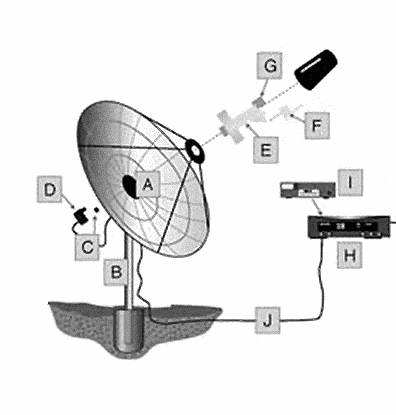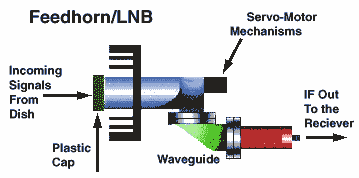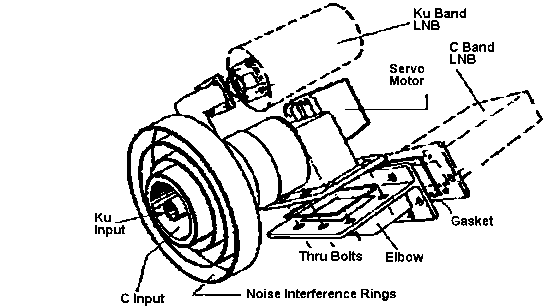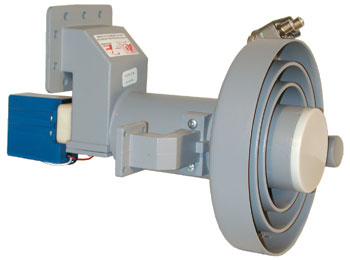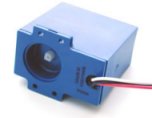Big Dish Satellite T.V. Dish Components: Difference between revisions
| (6 intermediate revisions by the same user not shown) | |||
| Line 1: | Line 1: | ||
== Large Dish | == Large Prime Focus Dish == | ||
{| | {| | ||
| Line 43: | Line 43: | ||
'''LNA''' - The low noise amplifier (LNA) is a special type of amplifier used in older satellite systems amplify and receive weak satellite transmissions from space. Early communications satellites transmitted at a lower power. Early Satellite systems used the a LNA or Low Noise Amplifier and no conversion was done in the LNA. | '''LNA''' - The low noise amplifier (LNA) is a special type of amplifier used in older satellite systems amplify and receive weak satellite transmissions from space. Early communications satellites transmitted at a lower power. Early Satellite systems used the a LNA or Low Noise Amplifier and no conversion was done in the LNA. | ||
'''LNB''' - The LNB (Low Noise Block Downconverter)converts the signal from the satellite into a signal for the receiver. Some feedhorns come with LNBs. | '''LNB''' - The LNB (Low Noise Block Downconverter)converts the signal from the satellite into a signal for the receiver. Some feedhorns come with LNBs. The functions of the LNB were at one time provided by two separate components, a Low Noise Amplifier (LNA) for signal amplification and a block down converter for down conversion. | ||
'''LO''' - The LO (Local Oscillator) is the frequency of the LNB itself. So you have the received Satellite signal frequency which is one value, and the LO which is another value. When the LNB convers the Satellte signal to one digestable by the receiver, the frequency adjustment is made by subtracting the LO frequency from the satellite frequency. There are different LOs providing different frequency ranges. | '''LO''' - The LO (Local Oscillator) is the frequency of the LNB itself. So you have the received Satellite signal frequency which is one value, and the LO which is another value. When the LNB convers the Satellte signal to one digestable by the receiver, the frequency adjustment is made by subtracting the LO frequency from the satellite frequency. There are different LOs providing different frequency ranges. | ||
| Line 61: | Line 61: | ||
== LNB Types == | == LNB Types == | ||
LNB stands for Low Noise Block downconverter. | LNB stands for Low Noise Block downconverter. C Band LNB's are measured in degrees Kelvin, with a lower number representing a higher grade LNB. Ku band LNB's are measured in decibels, with a lower number also representing a higher quality LNB. | ||
* | {| | ||
|- | |||
| | |||
[[Image:littlelnbexamplediagramdeal.png]] | |||
| | |||
[[Image:littlelnbexamplediagramdeal2.png]] | |||
|} | |||
* '''Standard LNB''' - 10 GHz LO, works for one band only. Normally has a feed horn assembly built onto the LNB. This LNBs polarization switching is done by a DC voltage on the coax - 12.5 to 14.5 volts gives vertical and 15.5 to 18 volts gives horizontal. | |||
* | * '''Universal LNB''' - works in two bands, 10.8 to 11.8 GHz and 11.6 to 12.7 GHz while having LOs of 9.75 and 10.60 GHz. Band switching is done via a 22 KHz tone sent from the satellite receiver. With the tone on the LO is 10.6 GHz, otherwise it is 9.75 GHz. Polarization is controlled the same as in the "STANDARD" LNB. A tone is sent to the Universal LNB at 22 KHz to tell it to switch from one band to another, such as from high to low, or low to high. Modern satellite receivers have the 22 KHz functionality built in. | ||
* | * '''Enhanced LNB''' - works from 10.7 to 11.7 GHz and has a 9.75 GHz LO. These were designed for the Astra satellites and have a built in feed assembly. Polarization is controlled the same as the "STANDARD" LNB. | ||
When looking for a feedhorn / LNB combo, remember 4DTV compatibility is recommended since nearly all C-band programming has moved to digital, and 4DTV is digital C-band. | When looking for a feedhorn / LNB combo, remember 4DTV compatibility is recommended since nearly all C-band programming has moved to digital, and 4DTV is digital C-band. | ||
* C/Ku/DBS Feedhorn | |||
: [[Image:ckudbsfeedhornpic.jpg]] | |||
| |||
== Miscellaneous Illustrations == | |||
{| | |||
|- | |||
| | |||
* Feed horn Cover | |||
[[Image:bigdishfeedhorncap.png]] | |||
| | |||
* Chaparral Feedhorn Cap | |||
[[Image:feed_horn_cap.gif]] | |||
| | |||
* Servo Motor | |||
[[Image:servomotorExample.jpg]] | |||
|} | |||
Latest revision as of 12:59, 6 May 2008
Large Prime Focus Dish
|
A. Dish B. Ground Mount C. Dish Mount D. Motor E. Feedhorn F. LNA / LNB G. Servo Motor H. Indoor Receiver I. Indoor Decoder J. Cable |
A modern system's major components include: Receiver, dish, dish mover, decoder module, feedhorn, and LNB.
Ball Screw vs. Acme Thread - Related to the type of dish mover you choose. The acme thread has become known as the industry standard. It is a mechanically reliable system that will push and pull your dish for many years with minimal maintenance. The improved ball screw arm system adds ball bearings to the nut that moves up and down the threads for added power on big dishes. This offers a smoother, quieter operation and a longer life, especially on large size dishes.
Decoder Module - The decoder module, which fits inside your receiver, descrambles subscription channels for programming that you have purchased.
Dish Mount - It is critical that your dish be mounted on a solid and stable mount to ensure peek reception. Ground shift, wind, and settling can all degrade or prevent clear reception. Different mounts include, pole mount, roof mount kit, tripod, ground bases and so on. The pole mount into the ground is a standard and only steel pipe, schedule 40 or thicker, should be used for any installation.
Dish Mover - The dish mover (or actuator or jack arm) attaches to the polar mount and controls the east and west movement of your dish.
Feedhorn - The feedhorn collects the reflected signal from the dish and sends it to the LNB. The feedhorn you need is determined by the types of satellites you want to watch: C-band, Ku-band, DBS, or all three.
LNA - The low noise amplifier (LNA) is a special type of amplifier used in older satellite systems amplify and receive weak satellite transmissions from space. Early communications satellites transmitted at a lower power. Early Satellite systems used the a LNA or Low Noise Amplifier and no conversion was done in the LNA.
LNB - The LNB (Low Noise Block Downconverter)converts the signal from the satellite into a signal for the receiver. Some feedhorns come with LNBs. The functions of the LNB were at one time provided by two separate components, a Low Noise Amplifier (LNA) for signal amplification and a block down converter for down conversion.
LO - The LO (Local Oscillator) is the frequency of the LNB itself. So you have the received Satellite signal frequency which is one value, and the LO which is another value. When the LNB convers the Satellte signal to one digestable by the receiver, the frequency adjustment is made by subtracting the LO frequency from the satellite frequency. There are different LOs providing different frequency ranges.
Micro Mesh - Micro Mesh is a breakthrough in the mesh dish industry. Micro-Mesh increases C/Ku-band performance by giving the dish surface a truer parabolic shape.
Receiver - The receiver (or "IRD - Integrated Receiver Decoder) connects to the LNB on the dish and the television, it is the unit that sits on top of your T.V.
Servo Motor - This device sits on your feedhorn and allows you to switch from vertical to horizontal polarities, thus enabling you to receive both odd and even channels.
T.I. & Bandwidth Filters - These filters deliver the best possible picture of every channel, even if your system is affected by terrestrial interference (T.I.), or if certain channels require custom bandwidths.
VCRS Decoder Module - These modules allow access to scrambled signals and pay-per-view programming with monthly or annual subscriptions.
LNB Types
LNB stands for Low Noise Block downconverter. C Band LNB's are measured in degrees Kelvin, with a lower number representing a higher grade LNB. Ku band LNB's are measured in decibels, with a lower number also representing a higher quality LNB.
- Standard LNB - 10 GHz LO, works for one band only. Normally has a feed horn assembly built onto the LNB. This LNBs polarization switching is done by a DC voltage on the coax - 12.5 to 14.5 volts gives vertical and 15.5 to 18 volts gives horizontal.
- Universal LNB - works in two bands, 10.8 to 11.8 GHz and 11.6 to 12.7 GHz while having LOs of 9.75 and 10.60 GHz. Band switching is done via a 22 KHz tone sent from the satellite receiver. With the tone on the LO is 10.6 GHz, otherwise it is 9.75 GHz. Polarization is controlled the same as in the "STANDARD" LNB. A tone is sent to the Universal LNB at 22 KHz to tell it to switch from one band to another, such as from high to low, or low to high. Modern satellite receivers have the 22 KHz functionality built in.
- Enhanced LNB - works from 10.7 to 11.7 GHz and has a 9.75 GHz LO. These were designed for the Astra satellites and have a built in feed assembly. Polarization is controlled the same as the "STANDARD" LNB.
When looking for a feedhorn / LNB combo, remember 4DTV compatibility is recommended since nearly all C-band programming has moved to digital, and 4DTV is digital C-band.
- C/Ku/DBS Feedhorn
Miscellaneous Illustrations
|
|
|
